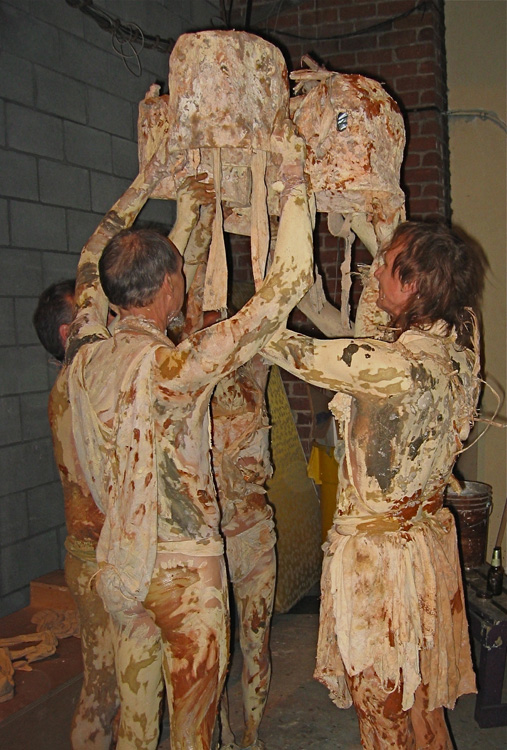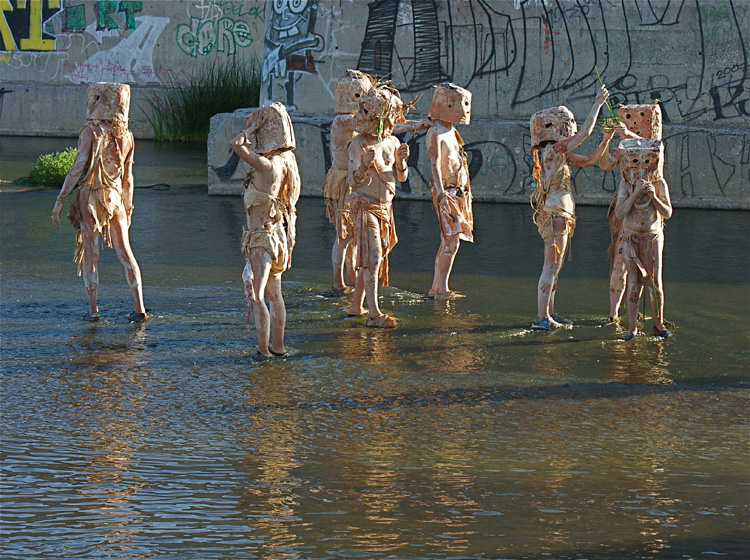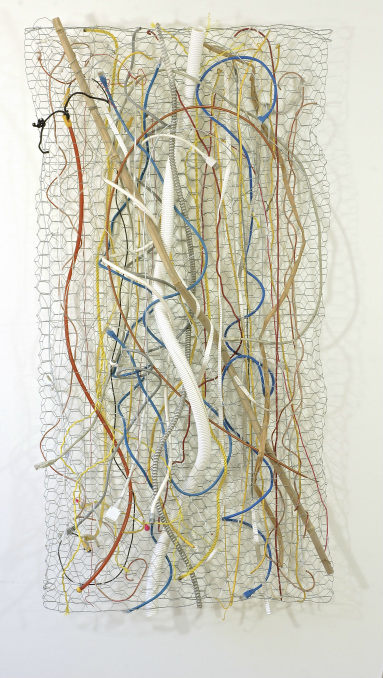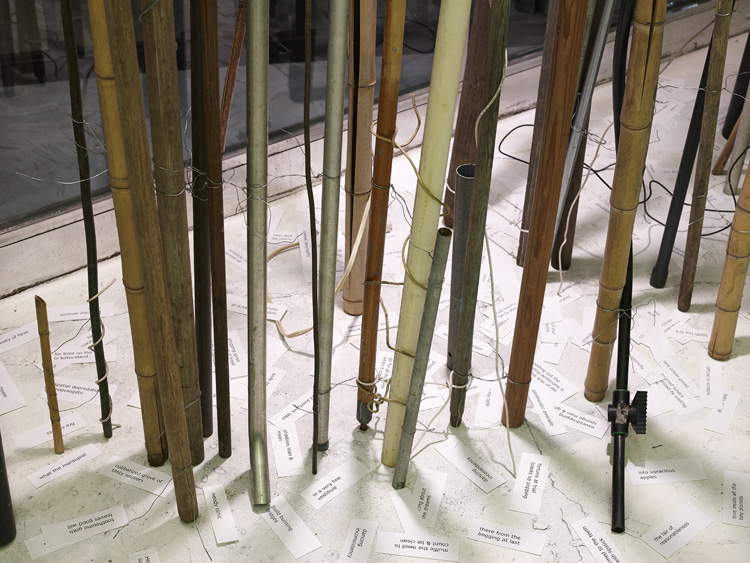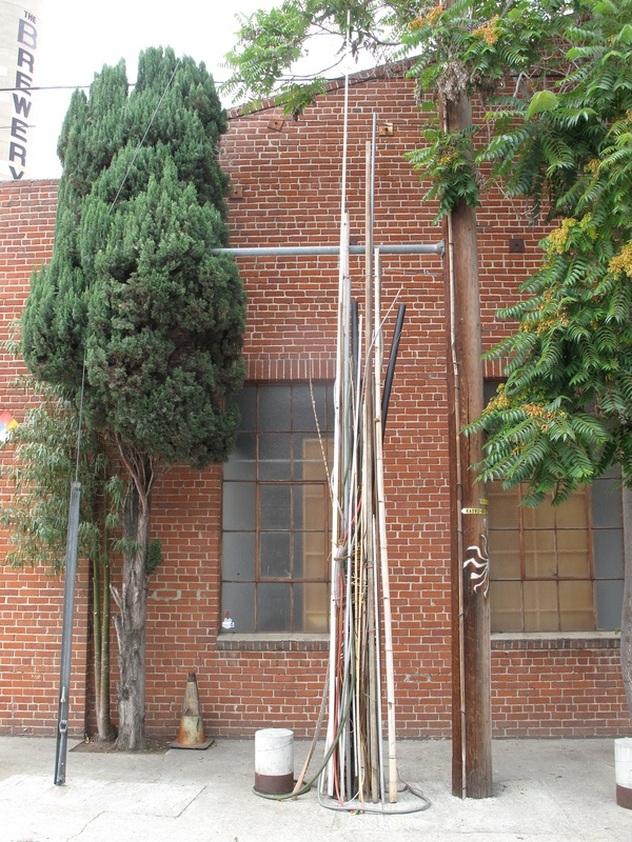
Performance art, sculpture, and installations – Mike M. Mollett is a versatile artist who creates both living and still-form art. The founder of L.A. Mudpeople, and the sculptor of large scale pieces created from found art, shaped into balls and bundles, Mollett’s work offers a look into a different reality, one in which what look like clay statues live and breathe, and bundles of wires move in the wind and become animate themselves.
On the performance art side, Mollett considers his troupe of L.A. Mudpeople to be non-performers who function as “essentially living sculptures.” Mudpeople don’t speak, and move slowly and deliberately, almost as if lumps of clay had shaped themselves and literally come to life. The troupe gets its mud from Silver Lake, Hollywood, and northern California, as well as using commercial mud such as potter’s clay. The artist started his mud-work in 1989, booking himself and others at an African-Reggae club for a single night – and the rest is art-tribal history.
L.A. Mudpeople vary in number, with sometimes as many as forty members participating in events like the Doo Dah Parade, or conducting walkabouts along the L.A. River, Melrose, or Old Town Pasadena. Their work has appeared in National Geographic Magazine, and exhibitions of their attire and artifacts have been shown at both UCLA and Cal State L.A. They’ve been the subject of a film, imitated by Leonard DiCaprio, and have become an iconic part of Los Angeles’ rich street art scene. The Mudpeople wear their own simple clothing, and create full head masks made from cloth, paper, mud, and binding. Conceptually, these living sculpture performances are all about the freeing of self from time and worry, muddy yogis who, according to Mollett “don’t have to do anything. We just are.”
Mollett has participated in the Los Angeles art scene for forty-some years, and it’s not all about “mudding-up.” His sculptures are often created from items and forms he’s used from work as a landscape artist, found objects that he morphs into what are essentially time capsules of society and life itself.
His sculpture balls include pieces like “Migrant World,” a bundle of artifacts that were gathered along the Arizona-Mexico border trails. Tied with rope and cords, viewers see a Mexican shawl, a battered pink backpack, a hat, water bottle, and baby bottle among other objects, built around an ocotillo wand armature. The over all effect is poignant – these are the belongings that people took with them as they migrated from one land, or realm, to the next. Mollett’s rope and wire bound “The Giant Ball,” features the detritus of modern society, such as milk cartons, wine bottles, paper bags, and pill containers. This, Mollett seems to be saying, is what we have allowed ourselves to be made of. The balls serve as personal sculptures that use material collected from Mollett’s life or another’s life, shaping a biography or autobiography of that person.
Unlike his balls, his Time-Twists of wire and wood are linear, reaching like mysterious urban plants skyward. “The Giant Bundle: A pLAyLAnd Twist” is installed indefinitely at The Brewery Artists Lofts in Los Angeles. His “Woody Bundle” includes an accordion tape measure. “Wild Red Twist” looks like shocking pink licorice has fused into corral, with blue, yellow, and black wires twisting in an invisible ocean wave. “Mostly Electric Story” incorporates rope, wires, and computer cables.
What makes both the Time-Twists and balls so compelling, is the feeling as if these entirely inanimate objects could suddenly become animate – just as Mollett’s Mudpeople do. A sinuous quality infuses the Time-Twists, making the viewer think of snakes, or strands of DNA twining and untwining. The balls are like transparent eggs filled with the stuff that life is made from, ready to hatch into human form.
Mollett’s “Gate Series” also feels embryonic. In “The 2nd GATE,” Wire mesh is woven with wires, ropes, sticks, bamboo, Dracaena Draco leaves, and twines. Mollett’s “Mostly Friendly GATE” also features Dracaena Draco leaves, orange, wire mesh, sticks, bamboo, wires, and ropes. The flat aspect of the gates resembles a thin slice of human tissue, the wires and leaves the inner-workings of the body, or the inner-workings of technology just as fragile, just as capable of being alive in a technology-driven world.
Installations like “Leaves in the Poet’s Winter Garden,” a part of Mollett’s solo show at Matters of Space in Highland Park, also use sticks, wires, and pipes to create the illusion of alive-ness. In this piece, pipe and bamboo stand tall, while at the base of these “plants” are small pieces of paper with two sets of disparate words or phrases written on them. A wonderful concept that illustrates the fluidity of creative thought, the passing “leaves” of discarded verbiage. Other installations have included a Mudcave at an Eagle Rock pop-up space, PlayLand, and The Mud Room created for the NadaDada Festival in Reno, Nev. Recently, Mollett was also a part of group exhibitions at Los Angeles Contraventions and the Los Angeles Juried Exhibition. Mudpeople have recently performed at the Highways Performance Space, as well as along the L.A. River, and at Beyond Baroque in Venice, Calif. You can find out more about Mollett’s work here: http://www.kcet.org/arts/artbound/counties/los-angeles/mike-mollett-la-mudpeople.html
– Genie Davis


